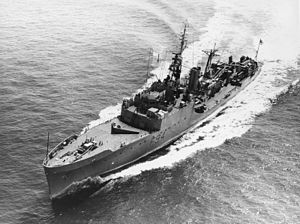Description
The Blackwood class displaced 1,180 long tons (1,200 t) at standard load and 1,456 long tons (1,479 t) at deep load. They had an overall length of 310 feet (94.5 m), a beam of 33 feet (10.1 m) and a draught of 15 feet (4.6 m). The ships were powered by one English Electric geared steam turbine that drove the single propeller shaft, using steam provided by two Babcock & Wilcox boilers. The turbine developed a total of 15,000 shaft horsepower (11,000 kW) and gave a maximum speed of 27 knots (50 km/h; 31 mph). [1] The Blackwoods had a range of 4,500 nautical miles (8,300 km; 5,200 mi) at 12 knots (22 km/h; 14 mph). Their complement was 140 officers and ratings. [2]
The ships were armed with three Bofors 40 mm guns in single mounts. The mount on the quarterdeck was later removed as it was unusable in heavy seas. The first four ships to be completed, including Blackwood, were fitted with two above-water twin mounts for 21-inch (533 mm) anti-submarine homing torpedoes, but these were removed in the early 1960s. They were equipped with two triple-barrelled Limbo Mark 10 anti-submarine mortars. The Blackwood-class ships had the same sonar suite as the larger Whitby-class frigates where the Limbo mortars were controlled by three sonars, the Type 174 search set, Type 162 target-classification set and the Type 170 'pencil beam' targeting set to determine the bearing and depth of the target. [3]
Construction and career
Palliser was laid down at Alexander Stephen and Sons' Linthouse, Glasgow shipyard on 15 March 1955. She was launched on 10 May 1956 and completed on 13 December 1957. [4] On commissioning, Palliser joined the Fishery Protection Squadron, serving with the squadron until April 1967. [5] As such she took part in the Cod Wars of the late 1950s and 1960s.
On 10 July 1960, the Icelandic gunboat Óðinn fired on the British trawler Grimsby Town, which was claimed to be fishing within Iceland's 12 mile territorial waters, with two shots hitting Grimsby Town's funnel. Palliser came up and prevented Óðinn from arresting Grimsby Town. [6] On 22 January 1971, Palliser was recommissioned into the 2nd Frigate Squadron based at Portland Harbour. [7] In May 1973 she was paid off and laid up for disposal. [5] In 1983 Palliser was to be scrapped at S Dean and Sons at Briton Ferry, Neath. Initial attempts to tow the frigate from Portsmouth were delayed by fog, and when on 9 February 1983, the tug Alnwick took Palliser in tow, Alnwick collided with Palliser, damaging the tug and forcing the two ships into Plymouth for repairs. When the tow recommenced, fog caused it to be stopped when the ships reached Swansea Bay, forcing the ships to miss the correct tide, causing a further delay of a week. When the ships finally reached Neath on 27 March 1983, Palliser ran aground before finally making it to the breakers. [5] [8]

HMS Plymouth was a Royal Navy Rothesay-class frigate. In 1982, Plymouth was one of the first Royal Navy ships to arrive in the South Atlantic during the Falklands War.

HMS Cleopatra (F28) was a Leander-class frigate of the Royal Navy (RN). Cleopatra was built at HMNB Devonport. She was launched on 21 March 1964, commissioned on 1 March 1966 and decommissioned on 31 January 1992.
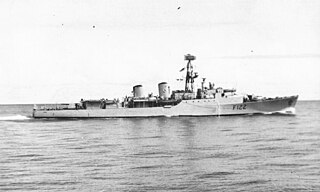
HMS Gurkha (F122) was a Tribal-class frigate of the Royal Navy. She was named after an ethnic group located in Nepal, and who continue to serve in the British Army. She was sold to the Indonesian Navy in 1984 and renamed KRI Wilhelmus Zakarias Yohannes (332).

HMS Mohawk was a Tribal-class frigate of the Royal Navy in service from 1963. She was named after a tribe of Native Americans located in southeast Canada and New York State. Mohawk was scrapped in 1983.

HMS Yarmouth was the first modified Type 12 frigate of the Rothesay class to enter service with the Royal Navy.

HMS Torquay was a Type 12 Whitby-class frigate of the British Royal Navy. They were the first frigates to have the "V" form hull. This evolutionary design made it possible to be driven in head sea without the usual slamming which occurs with conventional destroyers of the time. Each frigate cost 3.5 million pounds and the first ship completed was Torquay in May 1956.

HMS Blackwood was the name ship of her class of second-rate anti-submarine frigates built for the Royal Navy in the 1950s.

HMS Grafton was one of a dozen Blackwood-class frigate of second-rate anti-submarine frigates built for the Royal Navy in the 1950s.

HMS Keppel (F85) was one of a dozen Blackwood-class frigate of second-rate anti-submarine frigates built for the Royal Navy in the 1950s. She was named for Augustus Keppel, who served during the Seven Years' War and was admiral of the Western Squadron during the American War of Independence.

HMS Murray (F91) was one of a dozen Blackwood-class frigate of second-rate anti-submarine frigates built for the Royal Navy in the 1950s. She was named for George Murray, who served during the late 18th and early 19th centuries.

HMS Pellew (F62) was one of a dozen Blackwood-class frigate of second-rate anti-submarine frigates built for the Royal Navy in the 1950s. She was named for Israel Pellew, who served during the French Revolutionary and Napoleonic Wars. He was brother to Edward Pellew, 1st Viscount Exmouth
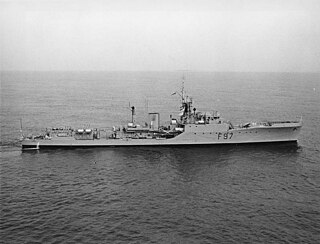
HMS Russell was one of a dozen Blackwood-class frigates of second-rate anti-submarine frigates built for the British Royal Navy during the 1950s. She was named for Edward Russell, 1st Earl of Orford, commander at the Battle of Barfleur in 1692.

HMS Rothesay was the lead ship of the Rothesay or Type 12M class of anti-submarine frigates of the British Royal Navy. She was commissioned in 1960 and scrapped in 1988.

HMS Brighton was a Rothesay or Type 12I class anti-submarine frigate of the Royal Navy.

HMS Falmouth was a Rothesay-class, or "Improved Type 12", anti-submarine frigate built for the Royal Navy during the 1950s. She took part in the Third Cod War in 1976, ramming the Icelandic gunboat V/s Týr. Both ships suffered extensive damage.
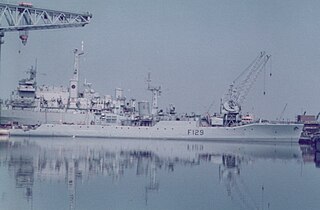
HMS Rhyl was a Rothesay-class or Type 12I anti-submarine frigate of the Royal Navy, launched by Lady Macmillan on 23 February 1959 and commissioned in October 1960. Following Royal Navy service she was scuttled whilst being prepared as a target in 1985.

HMS Lowestoft was a Rothesay-class or Type 12 class anti-submarine frigate of the British Royal Navy. Lowestoft was reconstructed in the late 1960s to largely the same pattern as the third group of Leander-class frigates, with new radar and fire control and a hangar and pad for a Westland Wasp helicopter for longer range, anti-submarine, engagement. In the late 1970s it was converted as the prototype towed array frigate for the Royal Navy, but retained its full armament. Lowestoft was sunk as a target on 8 June 1986 by HMS Conqueror using a Tigerfish torpedo. She was the last Royal Naval target to be sunk still displaying her pennant number.
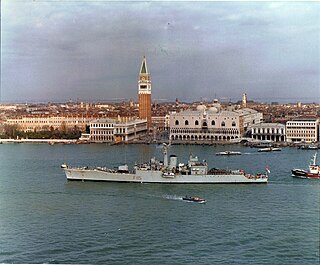
HMS Berwick was a Rothesay- or Type 12I-class anti-submarine frigate of the British Royal Navy. She was built by Harland & Wolff and launched on 15 December 1959.

HMS Eastbourne was a Whitby-class, or Type 12, anti-submarine frigate of the Royal Navy of the United Kingdom.
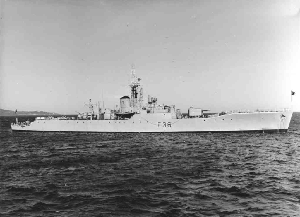
HMS Whitby was a Whitby-class or Type 12 anti-submarine frigate of the Royal Navy of the United Kingdom built by Cammell Laird and Co Ltd, Birkenhead. She was launched on 2 July 1954 and commissioned on 10 July 1956.
This page is based on this
Wikipedia article Text is available under the
CC BY-SA 4.0 license; additional terms may apply.
Images, videos and audio are available under their respective licenses.
